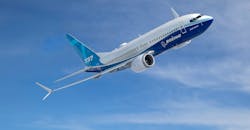FAA Outlines Next Steps for 737 MAX
The Federal Aviation Administration is proceeding to the evaluation stage for the data collected from the Boeing 737 MAX aircraft over three days of certification test flights, completed on July 1.
“The agency is following a deliberate process and will take the time it needs to thoroughly review Boeing’s work,” according to an FAA statement. “We will lift the grounding order only after FAA safety experts are satisfied that the aircraft meets certification standards.”
The 737 MAX is a twin-engine, narrow-body aircraft that Boeing introduced in 2017. After the crashes in October 2018 and March 2109 killed 346 passengers and crew members, it was concluded that the flight-control software (Maneuvering Characteristics Augmentation System, or MCAS) prevented pilots from overriding a movement that accelerated the jets toward the ground — in an effort to prevent engine stalling on takeoff.
Boeing has revised the MCAS, which was the focus of the test flights, conducted by pilots selected by FAA and Boeing.
The FAA aims to determine whether the MCAS revision and other updates will qualify the 737 MAX series for air-worthiness certification, which would allow Boeing to reprogram hundreds of aircraft already built, and then to resume deliveries of completed jets.
However, FAA's statement identified further milestones to be completed before it will grant certification:
JOEB Validation & FSB Review. The FAA’s Flight Standardization Board (FSB) and the Joint Operations Evaluation Board (JOEB), including safety-regulation agents from Canada, Europe, and Brazil, will evaluate minimum pilot training requirements, and issue a draft report of the consolidated findings for public comment.
Final FSB Report. FAA will publish a final FSB report after reviewing and addressing public comments.
Final Design Documentation and TAB Report. FAA will review Boeing’s final design documentation in order to evaluate compliance with all FAA regulations. The multi-agency Technical Advisory Board (TAB) also will review the final Boeing submission and issue a final report prior to a final determination of compliance by the FAA.
CANIC & AD. FAA will issue a Continued Airworthiness Notification to the International Community (CANIC) providing notice of pending significant safety actions and will publish an Airworthiness Directive (AD) that addresses the known issues for grounding.
The AD will advise operators of required corrective actions before aircraft may re-enter commercial service. At that point — and pending completion by operators of the work specified in the AD, along with any required training — the FAA would rescind the 737 MAX grounding order it issued in March 2019.
The FAA emphasized it will retain its authority to issue airworthiness certificates and export certificates for all new 737 MAX airplanes manufactured since the grounding, and that it will perform "in-person, individual reviews of these aircraft."
Also, FAA will review and approve training programs for all "Part 121 operators" (meaning, all the U.S. commercial carriers operating the aircraft.)
Some reports have indicated Boeing aims to have the 737 MAX regain its certification in September.
